
Different Rigs
Nahlah may be rigged in different ways. A full-length boom would work fine on the balanced lug mainsail, and a cat-ketch rig would work well, too.
Nahlah
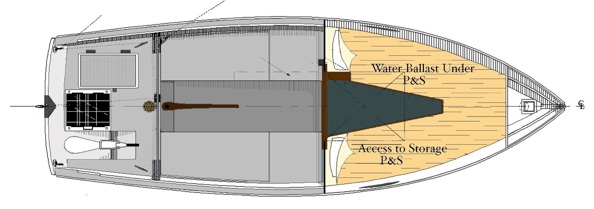
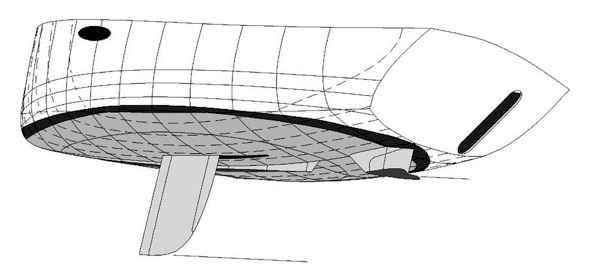
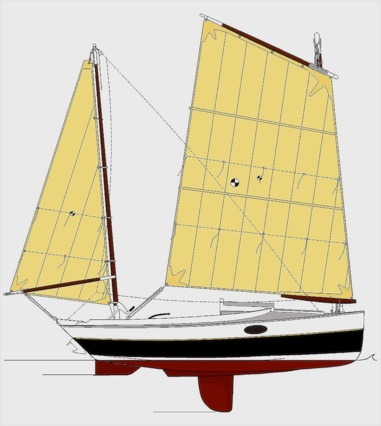
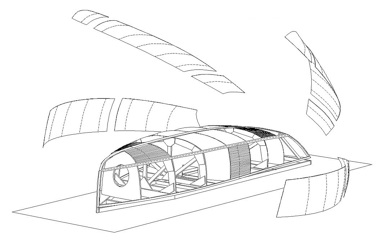
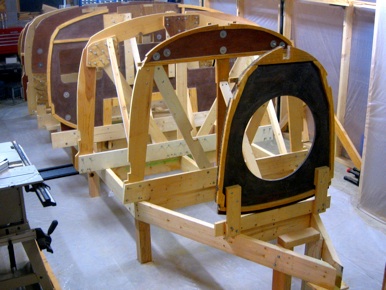

Hull #1 - a lovely job by Mike Walker, of Massachusetts.
Ready for interior work.
Hull #2 ( a slightly larger version) beautifully built by Al Kornhauser, of Virginia.
Ready for planking.
Copyright 2001-2021 inclusive McGowan Marine Design, Inc.
Nahlah is a fun and simple boat I worked on for years, and was reviewed in the design section of the July/August, 2003 issue of WoodenBoat magazine. Boat designer and builder Bob Stephens wrote in his review, "Attractive, comfortable, easy to build, and fast - Nahlah delivers. Surely that should be "enough"... shouldn't it?"
Nahlah - Arabic for “a drink of water”, is meant to be enough for the person with simple sailing needs.
Nahlah is an 18'6" (5.64 m) shoal draft trailerable yawl that combines traditional styling with modern performance and convenience. Her simple, powerful rig balances well with a sleek underbody. Water ballast simplifies trailering (though a lead shoe is also an option) and the fixed, winged rudder means you won't have to mess with moving parts or a sloppy helm. A big offset centreboard will ensure Nahlah is weatherly, while remaining out of the way. The roomy self-draining cockpit has space for four, and all sail and centreboard controls are within reach of the helm.
Aft of the cockpit an electric outboard provides auxiliary power. The outboard runs off a single 12v gel or AGM battery (located under the starboard berth, also acting as ballast). The battery is charged by a 20v solar panel located out of the way, beside the outboard. This quiet, environmentally friendly form of propulsion is also a good longterm investment. Surprisingly, as gasoline prices go up, the price of solar panels have been going down... and refills are free! A good sized locker is located below the solar panel. There is also storage in two large cockpit lockers.
Below, there are two berths and storage for cooking gear under the forward end of the cockpit seats. The ballast tanks are located below the berths. A cockpit tent would provide protection for two shorter people camping outside.
Construction is simple and strong, and is suitable for the amateur. I had originally recommended making compound curved strip-plank panels (picture below), but now suggest straight strip planking as her shape is a very easy one to strip-up. 1/2" (13mm) wide strips of suitable wood is ripped square from 3/4" (19mm) boards for the planking. The wide arced bottom and high ballast ratio will give her excellent stability, and round hull forward means she's not likely to experience the eddying, odd steering and pounding of some sharpie types of hulls.
(Note: more ballast has been added since the WoodenBoat article)
LOA - 18'6" (5.61m)
LWL - 15' 6-3/8" (4.73 m)
Beam - 6'3" (1.90m)
Draft - 11"- 3'-1" (.28-.94 m)
Displ.- 1,775 lbs (805 kg)
Ballast - 680 lbs (309 kg)
SA/WS - 2.3
SA/D - 20.6 Cp -.55
D/L - 203
Ballast/D - .38
Some construction pictures:
Particulars and Ratios
